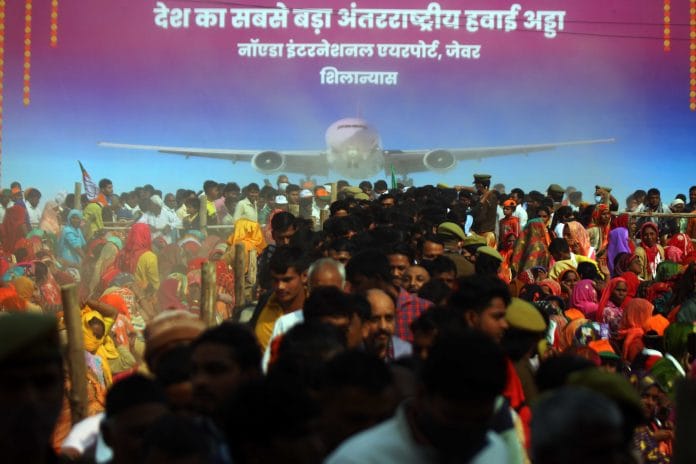After a long delay, Uttar Pradesh’s Jewar Airport now appears to be a real and imminent energiser to Noida and Greater Noida’s dreams of becoming a major Make-In-India manufacturing hub of NCR. With that, the competition between Gurugram and Noida to be the top business-friendly, liveable suburb has heated up.
But the Haryana government’s new law — which came into effect last week — to reserve 75 per cent blue-collar private sector jobs for the local population is now likely to play into this intense race between the two satellite cities. Some industry observers are already predicting a flight of capital from Gurugram to Noida. In this healthy rivalry of nearly three decades, Noida has had its moments when it showed promise but kept losing to the millennium city. This time too, to Uttar Pradesh’s Jewar, Haryana is answering with Hisar airport.

“Our competition is not Noida,” dismisses Haryana’s Deputy Chief Minister Dushyant Chautala in an interview to ThePrint. The private job quota law is his brain child and an election promise. “Noida being Noida has not really developed in so many years. We do not foresee any competition with Noida. As for Jewar Airport, Hisar is also coming up,” he says.
As soon as the legislation was passed last year, business historian Gurcharan Das wrote in a column for ThePrint: “The 75 per cent domicile law demonises the migrant.”
Industry observers say that freedom of labour mobility is key to manufacturing growth in any region. By restricting labour predominantly to Haryana, they suggest, the state will lose out to competition.
The Haryana State Employment of Local Candidates Act, 2020, mandates private companies to reserve 75 per cent of those jobs that cost employers Rs 30,000 or less per month.
“Most of the labour in industries would fall in the bracket of earning below Rs 30,000 and this implementation effectively closes up job opportunities for those outside Haryana. The requirement for industries to update the Haryana Udhyam Memorandum Portal with information on vacancies every three months is also a cumbersome process,” says Harbhajan Singh, Chairman, Taskforce (ease of doing business) at CII.
Enacting the law and bringing it into force wasn’t smooth. The deputy CM probably hadn’t asked the industry before promising this legislation in the run up to the 2019 assembly polls. Casting a popular poll promise into a policy frame that requires views of multiple stakeholders is seldom easy. Haryana launched into one year of hectic cajoling of industry bodies, building political consensus and defending the law in the high court that is scheduled to hear the matter on 2 February. The Gurugram Industrial Association moved the Punjab and Haryana High Court on 13 January even as the Act came into force.

Haryana is not an exception in adopting protectionist policy measures when it comes to jobs. Andhra Pradesh was the first state to attempt passing such a law in 2019. But the legislation stands challenged in the high court for being unconstitutional. Karnataka too has passed provisions giving preference to Kannadigas in hiring, results of which, experts say could be disastrous.
Also read: Why Coimbatore, Indore & Surat will decide success of India’s urbanisation. Not Mumbai & Delhi
Airport war and beyond: The real estate marker
Dushyant Chautala says Jewar will be built on 5,000 acres of land. But Hisar, he added, will be on 7,500 acres, expected to be ready this year and hopes to attract industries like aero defence, and export sectors.
But that’s just one big-ticket flagship project. Can you pin an economy on an airport? The air traffic is directly linked to the state of the local economy. See the fate of Narendra Modi government’s flagship Regional Connectivity Scheme. There are other factors — real estate, infrastructure and of course law and order — that lay the foundations of a growth story.
Between Noida and Gurugram, it isn’t just an airport war. The two suburbs are frequently compared on both ease of doing business and ease of living indices. Noida raced ahead of Gurugram in cleanliness this year, but the latter was ranked the most liveable city during the coronavirus pandemic because of the hospital availability. Noida is catching up pretty fast. According to JLL India, the Uttar Pradesh town has managed to race ahead of Gurugram for three consecutive quarters since Q22020 when it comes to commercial realty. In 2020, it accounted for around 1.78 million sq ft (MSF) of net office space absorption, against Gurugram’s 1.40 MSF.
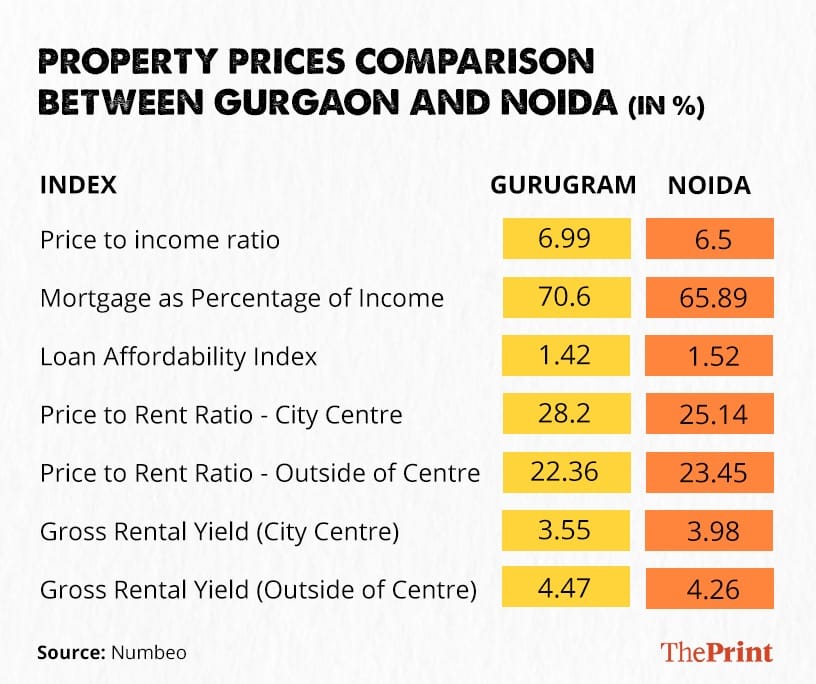
In terms of offtake of housing units, Gurugram takes the lead, followed by Noida-Greater Noida and Ghaziabad. There is, however, a trust deficit in Noida’s real estate with some of the reputed realtors failing to complete their projects. But as low prices continue to drive investment, people are still opting for Noida.
Since almost any new venture that wants to set up base close to Delhi eyes either of these cities, various websites, especially those dealing with property rates, keep a tab on the development of the two hubs.
While Dushyant Chautala may have said Noida is not Gurugram’s competition, he did refer to reports that keep track of the developments in the two cities. The same goes for officials in the city’s respective municipal corporations.
Also read: Noida is growing, Ghaziabad is fading. The story of Uttar Pradesh’s two boom towns
What came first tells where they are headed
The origin story of the two suburbs has one crucial difference — ‘what came first’. And this, perhaps, also defined their growth trajectories.
Harsh Singh Lohit, who once ran an IT company, Headstrong, set up in Noida in 1999, says that while Gurugram’s industries came up as a response to the DLF housing schemes, in Noida, industries were set up in collaboration with the state government when expansion of Delhi’s Okhla Industrial area essentially became NOIDA. Housing in Noida came up as a response to the needs of the employees of industries set up.

Now, Nodia is poised for its next boom. MoUs with Swedish furniture giant IKEA that plans to invest Rs 5,500 crore for setting up shopping malls and hotels and with South Korea’s Changwon to name a few. Vipin Malhan, head of Noida Entrepreneurs Association, says that even ‘crisis factor’ such as electricity have improved significantly, with manufacturing units receiving almost 23 hours of uninterrupted power supply in Noida.
Noida has traditionally been an industrial city. Its perception has, however, gotten better over the years, especially in terms of ease of doing business. Be it transparency or time taken for getting certain permits, or even the behavioural aspect of officers towards industries, it is pretty good, says Noida DM Suhas LY.
And that’s where Haryana’s contested new law comes in.
“It is a disaster for services-based industry like IT which employs 4 million-plus people, and contributes to $200-billion in revenue and foreign exchange to the country,” says technology analyst and commentator Prasanto Roy.
But the Haryana deputy CM defends his government’s decision, saying “Local labour is cheaper because companies do not have to take care of their housing and transport. We had multi-level discussions with corporations, and we reduced the amount to Rs 30, 000.”
“If there is a specific skill that does not exist in Haryana, the exemption will be allowed from time to time,” added Chautala.
Also read: Noida’s swachhta rankings jump has a lesson for Gurugram, Faridabad — get people on board
Maruti cranked up Gurgaon, Noida booted with HCL
Both Noida and Gurugram, as they are positioned today, were established in the 1970s, three years after each other. While Gurugram’s push was the setting up of Maruti, which eventually became a joint venture with Japanese automobile giant Suzuki, it was still old Gurugram.
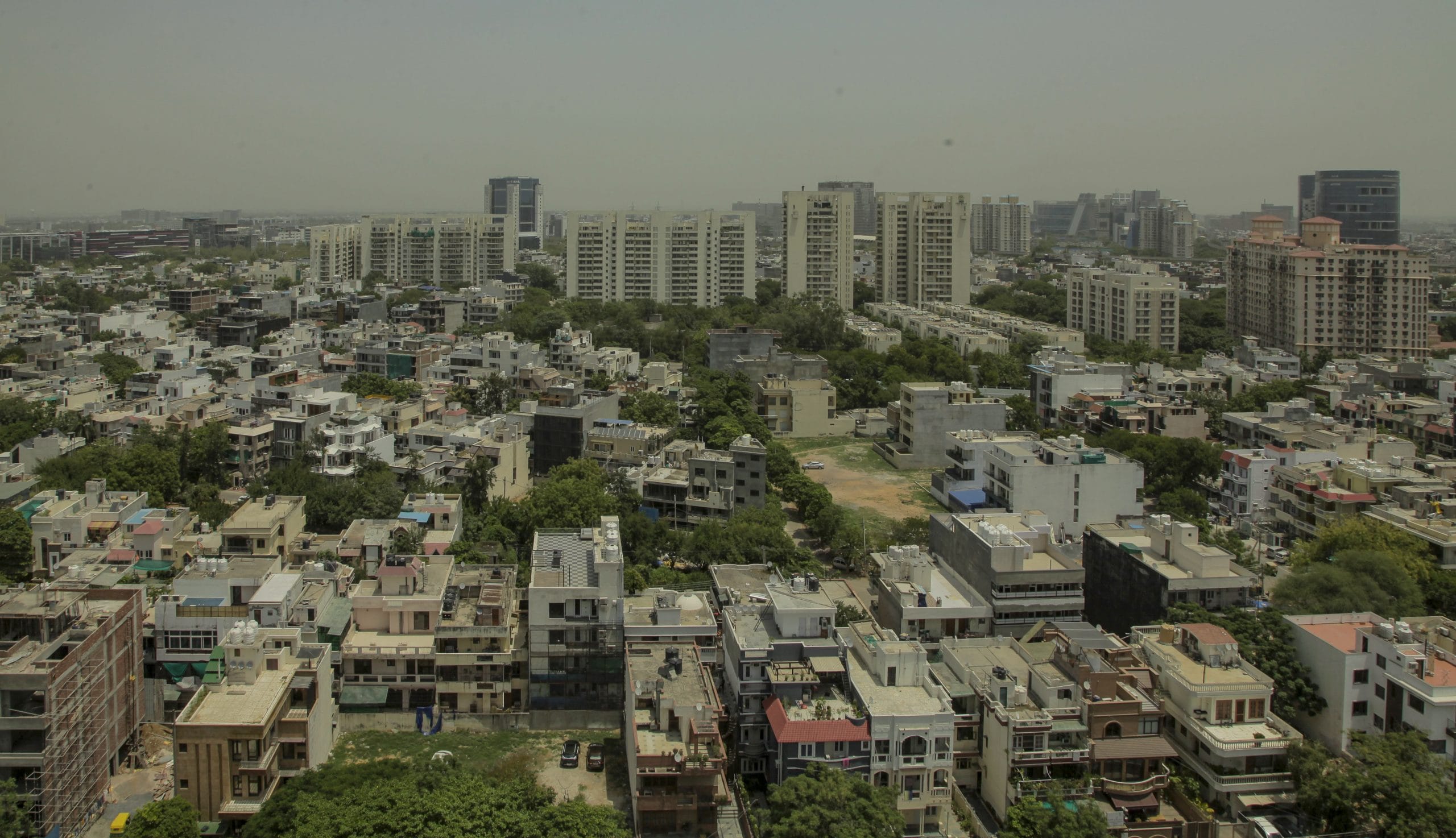
It was in the 90s, when India was still opening its gates to foreign businesses that DLF built the first large office space for General Electric and the wheels started turning for Gurugram. From then on, first DLF, and later in 2000s Unitech began acquiring land to change the city’s skyline. As for Noida, because it was an extension of Okhla Industrial area, the impetus was to set up factories/industries first.
What worked for Noida, was planned progress. Gurugram surged ahead when it came to construction, but until almost 2009, the municipal body had no masterplan of its own. Even Dushyant Chautala accepts how land acquisition is a big challenge for development, something his government seeks to correct by developing Hisar.
What began with the Maruti factory in the 1980s and Honda factory in late 1990s, Gurugram soon morphed into the face of new India’s software power, attracting the IT industry and tens of thousands of new BPO workers and later financial sector multinationals like Amex, Mastercard and Citibank. Noida, despite starting strong with the likes of HCL, couldn’t carry on with the initial momentum and is now holding on to the manufacturing potential of the IT revolution. Oppo, Vivo, Samsung and Lava are some of the electronics majors that have set up large mobile manufacturing units in the region and are expanding further.
“Back in the 1970s, most global companies chose Gurugram for their operations due to its proximity to the Delhi airport,” says Ajai Chowdhry, co-founder of HCL, who set up the software major in Noida in 1977. For the company, Chennai and Noida are profit centres. It did open an office in Gurugram, but never expanded its operations there. “Noida is UP’s showpiece, it is very critical for the state. So, it is supportive toward industries here. And Jewar can be the next game-changer for Noida.”
The two airports are expected to drive a trickle-down construction boom as well. After all, in 2019-20, the construction sector contributed around 18 per cent towards Noida and Ghaziabad’s overall economy.
Yashish Dahiya, founder of Policybazar, however, says that Jewar does not necessarily dramatically change everything. “Businesses are reactive, not proactive. So unless the construction is completed, there will not be massive changes.”
Also read: Gurugram is finally getting what it lacked. A culture Renaissance of sorts
High growth need solid foundations
There are other indicators too that define the growth trajectories – ease of living, cleanliness, transport.
When it comes to cleanliness, Noida surged ahead with the 4th rank in its kitty, while Gurugram trailed at the 24th spot in 2021 among cities with a population between one and 10 lakh.
“Construction-demolition waste is processed in our C&D plant in Sector 80 and apart from Delhi, Noida is the only other city in NCR that has such a facility,” says S.C. Mishra, DGM, Senior project engineer (public health), Noida Authority.
As Swachchhata rankings gain currency in collective perception, for those investing in these suburbs, be it retail or corporate, cleanliness will definitely be a deciding factor.
While Mishra points out that Noida has no landfills, Vaishali Rana, a Gurugram-based environmentalist says, “Every sector and municipal ward has a mini landfill in Gurugram. Segregation is practically negligible.”
Civic infrastructure is the millennium city’s Achilles Heel.
Thirty-six-year-old software professional Rohan Rawat says, “Various sectors get almost cut-off the moment it rains heavily because of water-logging. Some even witness power outages and water supply disruptions.”
Infamous for the lack of public transport, Gurugram residents have also worked toward greater connectivity. For too long, Gurugram was seen as the car-dependent city of new money. It woke up belatedly to idea of access.
Yasheh Yadav, former RWA president of Gurugram Sector 10, and the president of the unit that was set up in 2015 spearheaded the construction of the Dwarka Expressway, says “majority sectors of Gurugram from 57 to 115 have been connected to Delhi through this expressway.
“Old Gurugram till Sushant Lok 1 and MG road are usually the areas where people choose to live on rent or settle, because of better connectivity. The Kherki-Daula toll near Manesar is a major source of traffic jam. And the roads are not good compared to Noida,” says Yadav.
But Yadav also adds that property appreciation is much higher than Noida.
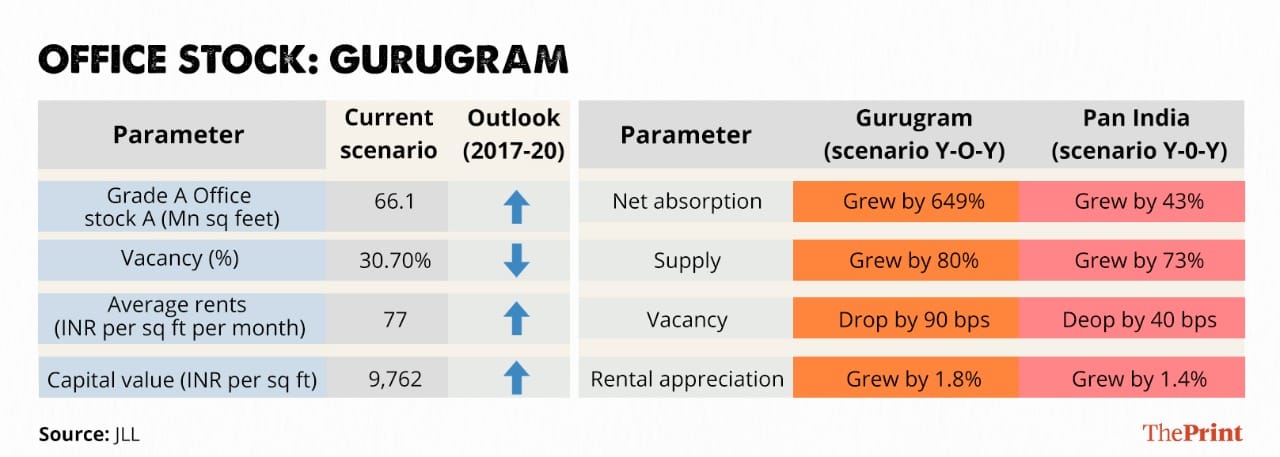
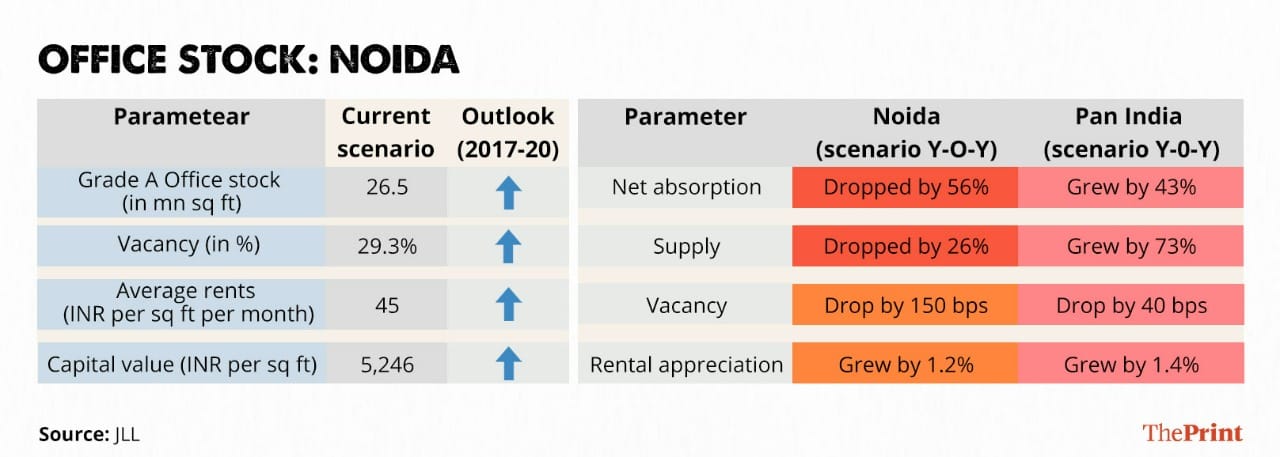
Also read: Noida has a new sector. It’s called humour
Delhi, Metro and the distance
While the Dwarka Expressway came into existence in 2015, there has not been much movement when it comes to metro expansion–a crucial link between Delhi and Gurugram. The proposed Rs 6,400 crore Metro extension plan has remained stuck for almost five years as the Haryana government could not finalise the route and the DPR till 2019. In June 2021, it was announced that the extension work will resume in 4-5 months, which has not yet started.
As for Noida, the story has not been remarkably different. The 15km-long Aqua Line extension is being built and will have a total of nine stations that will branch out from Sector 51. The construction is yet to begin.
Both the cities have a staggering lack of public transport. While in Noida, there are bus facilities from Botanical Garden metro station to various points in Greater Noida, intercity buses do not operate. Vipin Malhan, head of Noida Entrepreneurs Association, says that despite repeated requests for a public transport system for Noida, especially for making it more convenient for the labour force to get to their factories easily, nothing has come out of it.
Gurugram, on the other hand, has Gurugram Metropolitan City Bus Service that has around 150 buses, but needs 600 more to meet the city’s demands, according to GMDL. The service set up in 2018 has mostly been incurring losses with low ridership, affected by Covid as well, says a GMDL official, requesting anonymity.
Both cities rely on shared autos or public transport, or e-rickshaws, depending on the distance.
Also read: Greater Noida to Gurgaon — 5 NCR forests that you must visit before Corbett
Crime and its punishment for local economy
Noida has always had a sketchy reputation when it comes to law and order. And not just residents, this affects business decisions too.
Tanushree Basu who owns a clothing brand called Shorshe initially had her manufacturing unit in Noida as the labour was cheap. But after two years of operating from the city, she moved to Gurugram. Tanushree’s decision had multiple reasons but safety was a primary concern. She says, “Most of the designers engaged with her were women, who were commuting from Delhi. There was once an incident of chasing with a female employee. Even I used to try and move out of Noida by 8pm.”
But Noida is aiming to improve. It completed two years of commissionerate on 15 January 2022. The system gives more teeth to law enforcement agencies in keeping a check on crime.
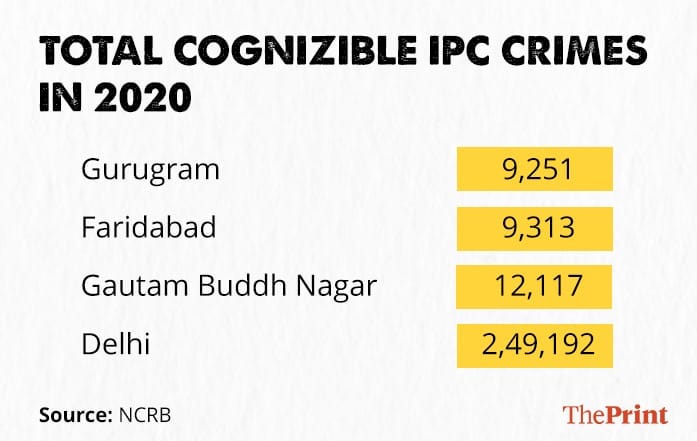
As per police data, instances of loot came down from 171 in 2019 to 75 in 2020 and further to 52 last year. There were 79 murders reported in the district last year against 81 cases in 2020. Overall, there were 12,609 cases filed in 2021 against 9,130 in the year 2020.
Police are looking to work on more ‘citizen friendly’ policies. Noida Police has also received approval for the formation of 10 new police stations in the coming months.
Despite paying a higher rent in Gurugram, by at least 30 per cent, Tanushree says she is content, as she feels the city is safer. She adds that her female employees too have echoed similar sentiments.
Both cities have dedicated helpline numbers for reporting crime. Subhash Bokken, PRO, Gurugram police says that the response time for helpline 112 is 10 minutes. Each section in Gurugram–East, West and South–has a dedicated women’s police station.
In terms of women’s safety, both the cities have taken up multiple measures. Vrinda Shukla, DCP (Women Safety) Noida, says “Women safety teams are deployed in every police station, and they are not saddled with any other duty.”
From special women and child safety rooms, to incentives for faster resolution of crimes against women, various measures have been taken up, especially since the Noida commisionerate was set up. 4,000 more police personnel have been inducted into the force and women personnel in the force has also doubled to 500, says Shukla.
Also read: Gurugram Inc won’t expand in Haryana anymore, eyeing hubs like Noida now
Education, power, water
Last year, the BJP-led government announced its plan to set up Indian Institute of Heritage in Noida. This is just one of the many additions the NCR town has made over the years when it comes to prioritising higher education, although primarily through private participation—Amity University, Shiv Nadar University, Sharda University attract students from all over the country, giving Noida that cosmopolitan character.
Chowdhry calls Noida more ‘family-oriented’ with its facilities, as opposed to Gurugram, which works more for corporate entities, be it through its microbreweries, pubs, or even Cyber Hub.
For all its ‘futuristic’ ambitions, the spread of higher education institutes is limited in Gurugram and the city is not the first choice, after Delhi.
Easy access to urban local bodies for grievance redressal make cities an attractive choice for citizens and here too Noida takes the lead over Gurugram. Rajan Yadav, a former RWA president, whose extended family lives in Gurugram, says Gurugram municipal authorities are not as accessible as the Noida Authority.
The power scenario in both these satellite towns tells a similar story. Erratic electricity supply is an indicator these new urban pockets are still struggling to find that right balance between catering to commercial and residential consumers—two groups who enjoy a symbiotic relationship in an urban conglomeration.
Ajai Chowdhry says when they started HCL operations, he had to arrange for backups of backup. Noida’s power situation was abysmal. Despite marked improvement since the 70s-80s, the city does reel under frequent power cuts even today.
The revision in electricity charges in September 2019 and demand for single electricity connections by the residents of housing societies have been a bone of contention between citizens and the authorities in Noida. Developers buy a single connection and those on rent/flat owners end up paying significantly more charges than the actual units used. Noida and its nearby areas also saw an upward revision in the electricity tariffs in September 2019.
Gurugram has no clear advantage over Noida in terms of power supply and the Haryana government’s ambitious zero-outage project after five years of its launch still has a lot to be desired. Jaswant Rao, RWA president of Astaire garden in Sector 70A Gurugram, says they receive messages from their discom almost every morning about load shedding, forcing them to use gensets, which generate exorbitant bills. This is the story in various sectors of Gurugram.
Thirty years of rapid urbanisation has stretched a key resource that will also have a role to play in the next leg of the growth story — water.
Between 2016 and 2020, in Gurugram, groundwater levels fell to 36.99 metres in 2020, and when it comes to Noida, the fall is 17 metres in the same duration.
Noida plans to complete its project to supply 37.5 cc of Ganga water by 2022 that could ease the water woes. The push towards hand washing during the peak of the pandemic in 2020 had forced the irrigation department in Haryana to raise alarm over water shortage across NCR.
Jiwan Sachdev, a Gurugram resident, says there are major water issues in sectors 81 to 115. These pockets majorly rely on GMDA tankers. Pipelines are laid for the supply of canal water in these sectors, and the developers have applied for water connections. But approvals are taking time, with Covid crisis in place, says Sachdev.
Also read: Rental housing in India is so broken, tenants and landlords are even teaming up in Delhi
Is Gurugram shutting out?
Gurugram began as the city of dreams — and the dreams were largely those of migrants — more so for the labour force it houses, than the C-suits it nourishes.
J.L. Mangla, representative of Gurugram Industrial Association, says that the job reservation will make it difficult for businesses to stay competitive. “There is a shortage of skilled and trained manpower locally. As people who have lived and earned livelihood in Haryana, even we want to incorporate local labour. But it cannot happen like this.”
Even those who might have not looked at Gurugram as their first preference, relocated for the jobs, convenience and amenities. Gurugram cannot move without its blue-collared workers, most of whom are not local, and yet it imposed a law that practically throws them out of the local economy.
Despite misgivings from the industry regarding reservation being a deterrent to the ongoing development of Gurugram, Dushyant Chautala is confident that the measure will create jobs and also aid development. Chautala says his govt is looking to attract e-vehicle manufacturing, and Haryana’s IT startups policy of 2017 is being re-drafted and a data-centric policy being studied to attract companies.
Chautala says, “The Haryana government has proposed to set up the first heli-hub of the country in Gurugram. It will be designed to have facilities like a heliport, hangars, repairs, and any other related services.”
Noida and Gurugram are like siblings, vying with each other to show Delhi how they are better. In this race for supremacy, each has its own unique offerings. But with the reservation law, Noida might become the favorite kid in the NCR block, with shinier industries.
“The irony is that Gurugram came up because of its openness, and now it’s closing,” says Samir Jasuja, founder, PropEquity. The policy, he says, is the best gift to Noida.
With inputs from Shubhangi Misra
(Edited by Anurag Chaubey)



